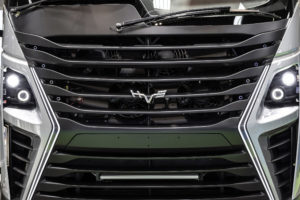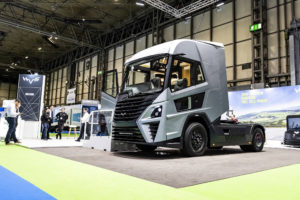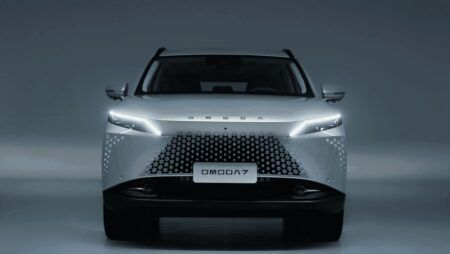Words Richard Gooding
The heavy-duty vehicle sector is under ever-closer scrutiny to reduce CO2 and greenhouse gas emissions. By 2040, all HGVs will need to be zero-emission and Hydrogen Vehicle Systems (HVS) is one of many industry players that believes hydrogen has a big role to play in the decarbonization of this notoriously difficult sector.
The HGV project began in 2018. “The business was established in 2017 and initially ran for a couple of years up to the pandemic,” says Pete Clarke, head of design. “As seen today with development at the Horiba MIRA proving ground in Nuneaton, UK, the Glasgow headquarters, and the early prototype build facility in Coventry, HVS progressed from 2020.” Rather than convert an existing OEM product, a ground-up approach was chosen because of the opportunity to design a fit-for-purpose vehicle.
HVS bought an OEM competitor truck and stripped it down to see how best it could incorporate the proton exchange membrane (PEM) fuel cell, hydrogen storage, the battery system, and other new technologies. “We were trying to crowbar a new technology set into a pre-existing vehicle design which was fundamentally designed for a completely different propulsion system,” says Clarke. “We are making compromises on space, packaging size, and performance. What we’ve chosen to do is take the propulsion system and design a vehicle around it, rather than the other way around.”
Set to hit production in 2026, with supported trials expected to begin in 2025, the 40-ton 4X2 HGV tractor unit sits on an all-new chassis. The hydrogen powertrain consists of pressurized hydrogen cylinders, fuel cells, an electrified rear axle, and an energy storage system – which acts as a buffer between the fuel cell and e-axle, regulating the power fed to the wheels. An electric motor transmits power to the wheels, and a Kinetic Energy Recovery System (KERS) recaptures energy under braking and while the truck is slowing down.

Established system
The fuel cell stack is an established system and will have a net power output of around 200kW (270hp), with a 300kW (402hp) version arriving in the longer term. There is a battery onboard to manage the power – the electricity required by the vehicle is created by the fuel cell, there is no ICE constituent – but one of the obvious benefits is there is no need to recharge a large battery usually required by a typical BEV truck.
This also means the battery is lighter, vital in the heavy goods sector where the payload carrying ability is crucial. “The comparison of a 3.5-5.0-ton battery in a 40-ton BEV truck compared to a 900kg fuel cell and hydrogen storage system means that weight saving is transferred directly to the additional payload capable in the trailer,” says Clarke. The battery system has a capacity of around 75kWh, but Clarke says capacity isn’t the most important value. “The real interest for us are the charge and discharge figures, in terms of the power we can get in and out of the battery system for propulsion and usage,” he says.
The demands of the HVS vehicle will favor a high-power battery not necessarily an energy dense battery, says Clarke. “An electric car or light commercial vehicle will typically have an energy factor where it needs to hold a lot of power, whereas our HGV is more transient, the battery is a buffer on the vehicle. We need high power in and out, essentially in the control of it. We’re working with a supplier that can bespoke our battery system on very different levels in terms of series and parallel configuration.”
Forecast range is 250-370 miles (400-600 kilometers), dependent on different parameters in real-world driving conditions, with 51kg of hydrogen on board, stored at 700 bar pressure. A choice of one, two or three hydrogen tanks are expected to be on offer, made predominantly from carbon fiber wrap, holding 10kg each at 350 bar pressure, 17kg at 700 bar. Refueling time is around 20 minutes. HVS’ strategic investment partner, the EG Group, can offer a refueling infrastructure, fleet customer base and the potential for global scalability.
Energy center
The integrated powertrain is controlled by HVS’ advanced control system ‘SEMAS’. This monitors interactions between the driver and control systems, helping fuel efficiency and durability. Dr David Telford, chief scientific officer, says optimization of the truck’s powertrain was approached as a more of an energy center rather than a traditional vehicle. “We have the opportunity to procure what we think is the best mature fuel cell and put in the matching battery system that works specifically for the duty cycle (see panel) we’re aiming for,” he says. “We also have a little flexibility with our vehicle design that we can change as the technology matures.” Goals include achieving high energy efficiency and fuel cell durability, while meeting the performance requirements through evaluation of the whole powertrain system including the optimization of route and load. The use of sophisticated simulation and CAD design has helped this optimization, even as far as simulating duty cycles and real-world terrain modeling with different powertrain combinations.
Clarke explains the clean sheet modular approach has allowed a more optimized design which envelops the whole vehicle. “The modularity affects almost every level of the main powertrain systems, from the e-axle, where we’re looking to offer 2 different power levels – up to 450kW (600hp) – dependent on customer needs; the modular hydrogen system with up to 3 cylinders that sits in the vehicle wheelbase, rather than at the back of the cab; the fuel cell derivation in terms of power, and the battery,” he says.
Duty calls
The accuracy of electric range distance depends on a variety of factors in the ‘real-world’, says Clarke, including terrain, payloads, and duty cycle. Telford believes that one of the key things that needs to be understood, around HGVs in particular, is that the energy required to complete a journey varies enormously with the road, route, and other factors. The duty cycle also plays a key role. “Vehicle range for an HGV is no one figure,” he says. “You have a reference duty cycle to compare vehicles over, and it makes sense if one has more range than the other. But that’s not necessarily the range achievable in the real-world,” he states, adding that real-world figures depend on the load carried and the driving terrain.
“On an HGV, the load you’re carrying determines energy consumption. But it’s also about what location. If a vehicle is on haul across predominantly flat prairie land in the US, then the range will be much, much bigger than a vehicle hauling up and down hills,” Telford says. “We believe that for the heavy goods segment, and a high load, high annual mileage duty cycle, hydrogen is a much better fit than other alternative fuel vehicles,” he adds. There will be some duty cycles where battery electric will be the clear winner, and others where hydrogen takes the victory, but a fit-for-purpose approach is vital. “We will start to get a realization in the marketplace that it’s about getting the vehicle needed for your duty cycle, rather than a do-everything vehicle,” says Telford.





